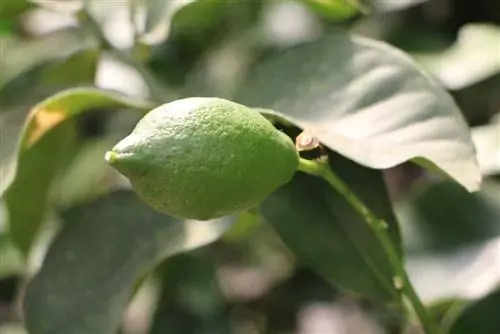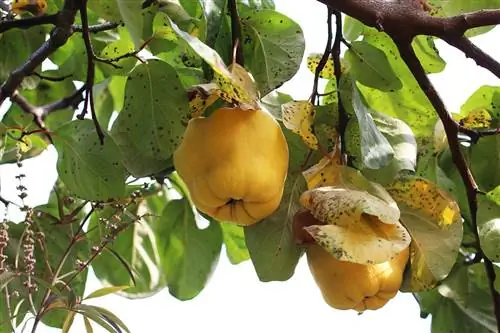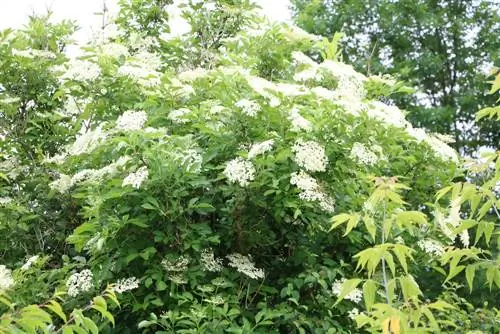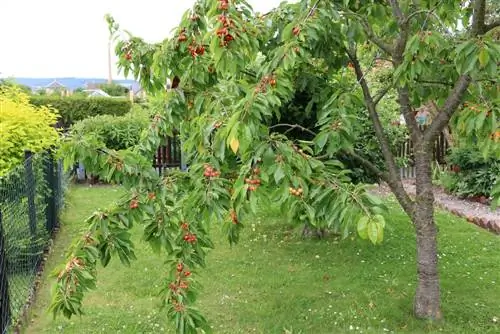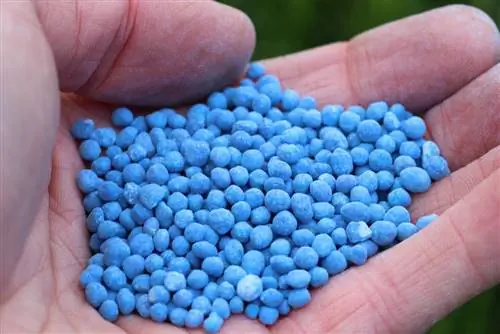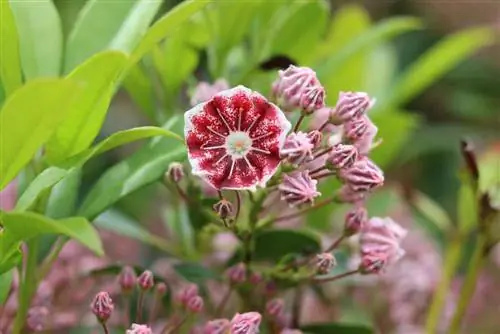- Author admin [email protected].
- Public 2023-12-17 03:39.
- Last modified 2025-01-24 12:45.
The citrus tree is one of the Mediterranean and evergreen plants. The botanical name 'Citrus' is related to the Greek word 'krèdos', which means 'tree with fragrant wood'. These plants not only impress with their external appearance, but also with their aromatic scents. In a sunny location in summer, the essential oils contained in the leaves evaporate and exude an intense, fresh, fruity scent. The lemon blossoms and fruits smell rather sweet but still pleasant.
Care
Due to their limited winter hardiness, citrus trees are usually kept in pots or buckets, where they become an eye-catcher on terraces and balconies. An optimally cared for lemon tree has a closed growth and a rounded crown shape. While in its natural habitat it grows up to 700 cm in height, in the pot it remains significantly smaller with a size of up to 130 cm, but this does not make it appear any less attractive.
The most important factor in care is wintering. If the right winter quarters have been found and the requirements of this plant are optimally implemented, that is half the battle. Nevertheless, site requirements and care measures such as watering, fertilizing and cutting should neither be underestimated nor neglected.
Location
As subtropical plants, citrus trees are real sun worshipers who want to be outdoors for as long as possible. Keeping it as a houseplant permanently is also possible but not recommended. The foliage would lose its rich green color because it requires a lot of light, which can only be guaranteed outdoors. In addition, flowering and therefore fruit setting often fail. Another point that speaks against exclusively indoor keeping is the higher susceptibility to pests.
- Preferably place outdoors from April to October
- Location should be warm, sunny and protected from wind and rain
- Bright midday sun in summer should be avoided
- Consistent temperatures are recommended in the area of the crown and soil
- Temperatures around 25 degrees are optimal
- If possible, choose a location on a south-facing window if you keep it indoors
- Spray regularly with room temperature water to increase humidity
Tip:
Indoor humidity can also be increased by filling a saucer with pebbles and water and placing the pot on top. The pot or root ball should not come into contact with the water.
Floor
The citrus tree needs loose, well-drained soil with a high humus content. There are special soils available commercially for citrus plants that are optimally tailored to the needs of these plants. If you prefer to mix the soil yourself, you can do this by mixing peat, compost and garden soil and adding coarse-grained components such as gravel or expanded clay to ensure good permeability.
Pouring
Citrus trees need to be watered regularly. The most important thing is to find the right amount, because these plants should neither be watered too much nor too little. Unfortunately, in most cases it is actually the case that too much is being watered. If the substrate is dry, it must be watered thoroughly and thoroughly. Allow the top layer to dry to a depth of about 1.5 cm until the next watering. It is best to water at larger intervals but abundantly. A moisture meter can prevent a lack of water but also waterlogging.
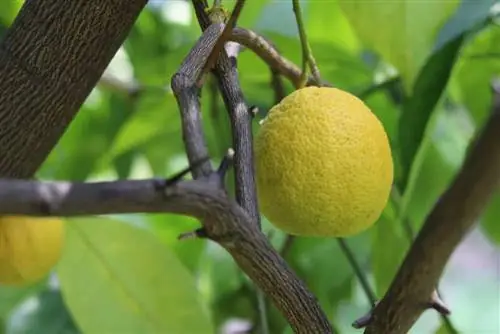
Until now, citrus plants should only be watered with low-lime or lime-free water. Scientific studies have now found that this is not fundamentally correct, because citrus plants also need calcium. That's why you should preferably water them with tap water, which should not be administered directly from the tap, but should be stale. Stale because the water when it comes out of the tap is too cold and the plants could react very sensitively to it.
Tip:
You should avoid planters or coasters if possible and place the pot on feet so that excess water can drain away immediately. If kept indoors, coasters and planters should be emptied shortly after watering.
Fertilize
In order to thrive, bloom and produce fruit, the lemon tree needs sufficient nutrients in addition to water. If you repotted at the beginning of the year, you can avoid additional fertilizer in the first few weeks. Otherwise, a high-quality citrus fertilizer should be administered every 1-2 weeks from the start of budding until September, if possible via irrigation water. Tap water supplies the plants with calcium, so that the plants are optimally supplied with all important nutrients and trace elements. Chalky tap water also has the advantage that it can prevent common iron deficiency and so-called chlorosis.
Wintering
The right winter quarters
Basically, a citrus tree should move into winter quarters as late as possible and back outdoors as early as possible. Depending on the region and weather conditions, it's time to bring them indoors around October, but definitely before the first frost.
- Classic winter quarters are unheated but frost-free greenhouses or winter gardens
- Cool side rooms with sufficient brightness are also suitable
- If light availability is limited, plant lamps can help
- Heated living spaces are unsuitable for wintering
- Reasons for this are lack of light, temperatures that are too high and air that is too dry
- At best, overwintering takes place bright and cool
- Temperatures between 5 and 10 degrees are optimal
- The warmer it is, the brighter the winter quarters should be
- On cold floors, place the plants on a polystyrene plate or coconut mat
- This prevents the root ball from cooling down too much
- Also ensure good ventilation without drafts
Tip:
If space in the winter quarters is limited, it can be helpful to cut away damaged and diseased parts of the citrus tree before moving. This has the advantage, among other things, that evaporation is minimized and pest infestation is counteracted.
Care in winter
At wintering temperatures of 5 - 10 degrees, citrus trees enter a dormant phase. Their metabolism is reduced, so that the roots almost stop their activity. As a result, the need for water is significantly reduced. On the other hand, if temperatures rise above 10 degrees, the metabolism is activated and the plant's vegetation starts. Since the citrus tree needs light for photosynthesis, which is only available to a limited extent in winter, it reacts to this by shedding its leaves.
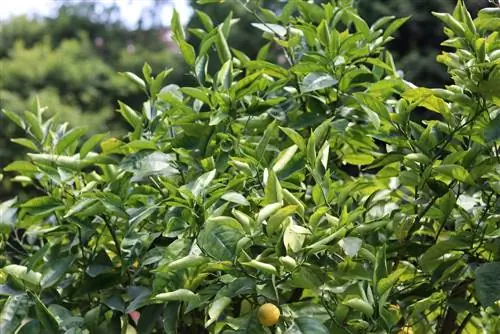
This leaf drop is often incorrectly associated with a lack of water. More watering is done, but this makes the problem worse because the less foliage there is on the plant, the less water it can evaporate. The result is a permanently wet substrate, which can lead to root rot and, in the worst case, complete death of the plant.
Therefore, attention should be paid to low temperatures and moderate watering. Usually it is enough to water the citrus tree every 4-6 weeks. In addition, occasional spraying with lukewarm water is recommended. Fertilizer can be dispensed with completely because at these low temperatures the roots cannot absorb these nutrients, they would have no benefit for the plants and would largely be washed out with the irrigation water.
Tip:
If citrus trees are too dark, so-called horny shoots often form, which should be better removed. Horny shoots are long, thin and weak shoots that deprive the plant of strength.
Pruning measures before wintering
Basically, when it comes to pruning citrus trees, less is more. It's best to cut as little as possible and as much as necessary. A distinction is made between maintenance and upbringing. The best time for both types of pruning is late winter or early spring, so the citrus tree has the entire season to compensate for the lost substance and form new shoots.
While maintenance pruning, as the name suggests, serves to preserve the plant and can extend into the green wood, training pruning aims to build a strong and stable basic structure and the early development of the crown. For older specimens that have not been trimmed for a long time and are already heavily bald, a rejuvenation cut can also be recommended.
Conservation cut
- Maintenance pruning involves, among other things, thinning out the crown a little
- Cut out damaged and diseased shoots that are too close together
- Always remove the weaker shoots from crossing shoots
- Always cut away shoots completely and directly at the base
- If they are shortened, they branch out again and thicken the crown
- Of two equally strong shoots from a branch, leave only one standing
- Short outer branches above a lateral branch or a bud by a third
- Short fruit-bearing branches by half after harvesting
- This allows new fruit wood to form again
Particularly if a citrus tree has been damaged by frost or pests, it may be advisable to cut it back to the new wood. On the one hand, this allows the interfaces to seal better and, on the other hand, the growth power is then concentrated on the new, unloaded wood.
Educational Cut
When pruning, you should always cut above the bud of a branch or, in the case of side branches, always at the base of the next stronger branch. The so-called lateral guide shoots are shortened by around a quarter of their total length. In addition, all competing shoots, crossing shoots, inward-growing shoots and shoots growing steeply upwards are removed. Of course, dead and diseased wood is always cut out to ensure good ventilation of the inside of the crown. Last but not least, shorten the main shoot so that it towers over the other side shoots by about 10-15 cm.
Rejuvenation pruning of older citrus trees
Citrus trees that have not been pruned or hardly pruned over a long period of time will eventually become so bare that they only have leaves on the tips of the shoots and there is hardly any new growth. Then it's time for a rejuvenation cut to revitalize the citrus tree. To do this, cut back all the stronger branches so far that stubs about 10-15 cm long remain, from which the lemon tree will then sprout again. The stronger the pruning, the more the plants will sprout again afterwards.
Teared bark at the interfaces should then be straightened with a sharp knife, otherwise germs and bacteria can quickly settle in and damage the plant. After such a rejuvenation cut, no fruit yield is expected for at least a year. In order to prevent the plant from becoming bald again, the newly formed, still herbaceous young shoots are shortened to 30-40 cm so that they branch out better.
Repot after cutting
Repotting is one of the first things to do in spring, along with pruning. This ensures permanently vital plants, beautiful flowers and fruit yields. Young lemon trees should be repotted into fresh soil every year and older ones about every 2-3 years, at the latest when the roots grow out of the drainage holes. The plant substrate and the choice of the right plant pot play an important role.
- Substrate should be water-permeable, structurally stable and nutrient-rich
- Ideally use special citrus plant soil
- Or a mixture of good garden soil, quartz sand and broken gravel
- When choosing a planter, prefer clay pots
- Clay pots are more stable than plastic pots
- The fine pores in the clay ensure minimal ventilation of the root area
- Pot should be a third larger than the root ball
- Or about 2 cm in diameter larger than the old pot
- As the bottom layer, a drainage layer several centimeters thick
- Pour some substrate on top
- Then place the citrus tree in the middle of the new pot at the same height
- Fill with fresh substrate, press firmly and water vigorously
When to go outside?
Even if the lemon tree should be brought back outside as early as possible, there is still a short period of getting used to it. When exactly that is depends again on the region and weather conditions. In any case, the nights should also be frost-free. First, just place the plant in a shady spot for a few hours during the day. Direct sunlight must be avoided at all costs as it would burn the relatively sensitive leaves of the citrus tree. The duration of the outdoor stay is gradually extended and the location becomes a little sunnier until the plant can finally be placed permanently in full sun again.
Propagate
Cuttings/cuttings
For propagation from cuttings you should only use he althy and strong mother plants. If necessary during the annual pruning in early spring, 10-15 cm long, half-woody cuttings are cut from shoots from the previous year. They should have several buds and 1-2 small leaves at the tip of the cutting. To minimize evaporation, the remaining leaves are shortened by about half.
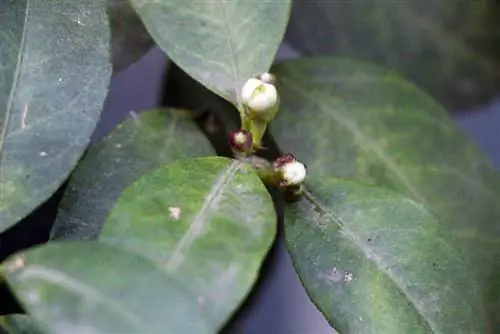
It is best to cut the cuttings diagonally, this makes it easier for them to absorb water. Now you put them with the cut into a rooting powder and then about 4 cm deep into small pots with potting soil. The cutting is pressed into the substrate and the substrate is moistened.
Then place a translucent plastic bag over the cutting or pot and place the whole thing in a warm and bright place without direct sunlight. The plastic bag should be removed daily for a short period of time to prevent mold and rot on the citrus tree. The potting soil should never dry out but should not be too wet either. As soon as the new shoots appear, the film is removed. If the pot ball is well rooted, it is repotted.
Sowing
For sowing, only seeds from fresh and fully ripe fruits, which can be bought in almost every supermarket, should be used. It is best to use small plant pots with appropriate drainage holes.
- First place a layer of smaller pebbles on the bottom of the pot as drainage
- Then comes standard potting soil
- Stick one or more lemon seeds about a centimeter deep into the soil
- Then moisten the substrate and put translucent foil over the pots
- Then place in a warm and bright location without direct sunlight
- It takes about 4-6 weeks for germination
- Substrate must be kept evenly moist without being permanently wet
- If the seedlings are about 10-15 cm tall, separate them into small pots
- It takes at least five years for the first flowers and the first fruits to appear
Diseases and pests
Root rot
Too much and persistent moisture can lead to root rot, as a result of which the plants lose leaves and fruits. If it is detected early, repotting may be able to save the plant. As a preventive measure, attention should always be paid to an airy substrate and appropriate watering behavior.
Leaf discoloration
Yellowed leaves on the citrus tree can be the result of too much or too little water. The watering quantities should be adjusted accordingly. Isolated yellow leaves are not a disease but completely normal. If necessary, the citrus tree needs to be thinned out a little so that more light can reach the inside of the crown.
Scale insects
Pest infestation mainly occurs when the winter is too dark and warm. Scale insects can be easily wiped off with a cotton swab dipped in alcohol. If the infestation is advanced, chemical agents, for example in the form of sticks, can be used to combat it.
mealybugs and mealybugs
Mealybugs on citrus trees can also be removed with a cotton swab soaked in alcohol. In addition, natural predators such as lacewings, ladybirds or parasitic wasps can be used or, in the case of severe infestation, appropriate chemical products from specialist retailers.
Spider mites
If you have a spider mite infestation, showering with a stronger jet of water can remove the majority of the pests. The undersides of the citrus tree leaves in particular should not be left out. In addition, spraying with plant decoctions or neem oil preparations is recommended. Lacewings, ladybirds, predatory mites and gall midges also provide good services.
Conclusion
Citrus trees are visually impressive with attractive foliage, fragrant white flowers and, under optimal conditions, ripe fruits. They conjure up a Mediterranean flair on terraces and balconies. Despite everything, these plants are quite demanding when it comes to site conditions and care, which you should consider before buying to avoid disappointment. But basically they are worth every effort.

